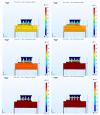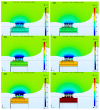Design and Performance Assessment of a Solid-State Microcooler for Thermal Neuromodulation
- PMID: 30393323
- PMCID: PMC6187761
- DOI: 10.3390/mi9020047
Design and Performance Assessment of a Solid-State Microcooler for Thermal Neuromodulation
Abstract
It is well known that neural activity can be modulated using a cooling device. The applications of this technique range from the treatment of medication-resistant cerebral diseases to brain functional mapping. Despite the potential benefits of such technique, its use has been limited due to the lack of suitable thermal modulators. This paper presents the design and validation of a solid-state cooler that was able to modulate the neural activity of rodents without the use of large and unpractical water pipes. A miniaturized thermal control solution based exclusively on solid-state devices was designed, occupying only 5 mm × 5 mm × 3 mm, and featuring the potential for wireless power and communications. The cold side of the device was cooled to 26 °C, while the hot side was kept below 43 °C. This range of temperatures is compatible with brain cooling and efficient enough for achieving some control of neural activity.
Keywords: biomedical microdevice; implantable; microdevice packaging; microsystem integration; neuronal; solid-state cooling; thermal neuromodulation; thermal simulation.
Conflict of interest statement
The authors declare no conflict of interest; “The founding sponsors had no role in the design of the study; in the collection, analyses, or interpretation of data; in the writing of the manuscript; or in the decision to publish the results”.
Figures












Similar articles
-
Wireless and batteryless biomedical microsystem for neural recording and epilepsy suppression based on brain focal cooling.IET Nanobiotechnol. 2011 Dec;5(4):143-7. doi: 10.1049/iet-nbt.2011.0017. IET Nanobiotechnol. 2011. PMID: 22149871
-
Cooling a low noise amplifier with a micromachined cryogenic cooler.Rev Sci Instrum. 2013 Oct;84(10):105102. doi: 10.1063/1.4823528. Rev Sci Instrum. 2013. PMID: 24182158
-
An Experimental Study on the Performance Evaluation and Thermodynamic Modeling of a Thermoelectric Cooler Combined with Two Heatsinks.Sci Rep. 2019 Dec 30;9(1):20336. doi: 10.1038/s41598-019-56672-9. Sci Rep. 2019. PMID: 31889101 Free PMC article.
-
Meta-analysis of the effects of microclimate cooling systems on human performance under thermal stressful environments: potential applications to occupational workers.J Therm Biol. 2015 Apr-May;49-50:16-32. doi: 10.1016/j.jtherbio.2015.01.007. Epub 2015 Jan 30. J Therm Biol. 2015. PMID: 25774023 Review.
-
Application of focal cerebral cooling for the treatment of intractable epilepsy.Neurol Med Chir (Tokyo). 2010;50(9):839-44. doi: 10.2176/nmc.50.839. Neurol Med Chir (Tokyo). 2010. PMID: 20885118 Review.
Cited by
-
Focal Cooling for Drug-Resistant Epilepsy: A Review.JAMA Neurol. 2022 Sep 1;79(9):937-944. doi: 10.1001/jamaneurol.2022.1936. JAMA Neurol. 2022. PMID: 35877102 Free PMC article. Review.
-
A medium-weight deep convolutional neural network-based approach for onset epileptic seizures classification in EEG signals.Brain Behav. 2022 Nov;12(11):e2763. doi: 10.1002/brb3.2763. Epub 2022 Oct 5. Brain Behav. 2022. PMID: 36196623 Free PMC article.
-
Editorial for the Special Issue on Wireless Microdevices and Systems for Biomedical Applications.Micromachines (Basel). 2018 Mar 5;9(3):112. doi: 10.3390/mi9030112. Micromachines (Basel). 2018. PMID: 30424046 Free PMC article.
References
-
- Accuray Research LLP . Implantable Medical Devices Market Analysis and Trends-Product, Material—Forecast to 2025. PR Newswire; New York City, NY, USA, October: 2016. Report.
-
- Anacleto P., Mendes P.M., Gultepe E., Gracias D.H. 3D small antenna for energy harvesting applications on implantable micro-devices; Proceedings of the 2012 Loughborough Antennas and Propagation Conference (LAPC); Loughborough, UK. 12–13 November 2012; pp. 3–6.
LinkOut - more resources
Full Text Sources

